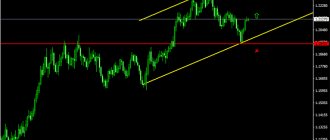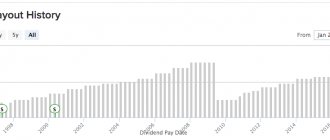The most important part of the overall financial development strategy of a joint stock company is the dividend policy. Its subject is the distribution of JSC profits, in other words, dividends between shareholders. Let's consider what approaches are used to formulate dividend policy, how effective its analysis is and what practical conclusions can be drawn based on the data obtained.
Question: How to reflect in the accounting of an organization (LLC) the payment of dividends to a participant - a foreign organization in foreign currency? In accordance with the company's charter, the portion of profit intended for distribution among its participants is divided in proportion to their shares in the authorized capital. According to the decision of the general meeting of participants, the amount of net profit (dividends) distributed in favor of the participant - a foreign organization - is 720,000 rubles. and is paid in euros based on the amount of distributed profit and the euro exchange rate established by the Bank of Russia on the date of the decision on the distribution of net profit (dividend payment). Dividends were paid to the foreign participant in the month the decision to pay dividends was made. The euro exchange rate established by the Bank of Russia was (conditionally): - on the date of the decision on the distribution of net profit - 72 rubles/euro; — on the date of transfer of dividends — 73 rubles/euro. View answer
What is the essence of dividend policy
Look, the company has issued shares. Investors bought these shares. Investors now want to receive part of the company's profits - that is, dividends. But the company still needs to grow and expand. Therefore, some part of the profit must be reinvested and put into production.
The question arises: “How much money should I pay investors?”
As a result, the Board of Directors meets and begins to resolve this issue. They reason, argue, offer different options. And by the end of their meeting they decide:
- What percentage of the company's income should be paid out to shareholders in the form of dividends.
- How often to make dividend payments (once a year, once a quarter, etc.).
- What dividends should be paid to holders of common shares and what dividends to holders of preferred shares.
These three decisions taken together constitute the dividend policy. When it is accepted and published, investors know what earnings the company can expect and when to expect them to arrive.
What to look for when analyzing dividend policy
If you decide to invest in dividend stocks, then you need to devote some time to analyzing the dividend policy. And, importantly, you need to understand how well the company implements its own policies. The fact is that policies are just guidelines, and sometimes companies violate them. Even state-owned companies, which must pay 50% of net profit under IFRS, do not always comply with this requirement.
So, what you need to pay attention to:
- For the duration of the policy. It is usually taken for a period of 3 to 5 years. It may happen that this year payments are made according to the old rules, and the next - according to the new ones, and the new option turns out to be less profitable for minority shareholders than the previous one.
- Basic principles of profit calculation . So, you need to find out what serves as the basis for paying dividends - net profit according to RAS, IFRS or FCF? Is there a profit-limiting ratio (eg net debt/EBITDA)? How does CAPEX affect dividends? Well, look at the other parameters.
- What part of the profit goes to dividends ? Less than 100% free cash flow is good. If more, it means the company is borrowing money to maintain a high level of payments or paying from reserves. In any case, a payout ratio that is too high is not good; it threatens to reduce the size of dividends in the future.
- How often does the company pay dividends - once a year, once every six months or quarterly? There are companies abroad that pay dividends monthly. In general, the more often the payment is made, the better.
And here’s another interesting article: What is an averaging strategy
I talk about other important points, the principles for calculating dividends by public and private companies, the differences between the bases for calculating dividends and other important things in the course “How to get rich by investing in dividend-paying stocks on the Russian stock market.” If you want to know more about companies' dividend policies, learn to understand them and avoid pitfalls, then I recommend studying it. Good luck, and may the money be with you!
Rate this article
[Total votes: Average rating: ]
Does the company always follow a dividend policy?
No. Because this is not an obligation, but a recommendation document. The dividend policy does not spell out all possible market disasters that may arise. Or internal problems that the company may have.
For example, a company operated for several years, received large profits, and paid dividends in accordance with its dividend policy. And then the quarantine began due to Covid. Profits have declined. In some branches of the company there is no profit at all. What to do?
In this case, the board of directors may decide not to pay dividends, but to use them to support the business. So that he “stays afloat” and does not go bankrupt.
The company may reduce the size of dividends and change the timing of their payment. In short, he can do anything.
Dividend policy for ordinary and preferred shares
If a company has ordinary and preferred shares, then each type of shares has its own dividend policy.
How ordinary shares differ from preferred shares and which ones are better for investors to buy - I wrote in a separate article. Here's a quick summary: common shares are voting shares, but preferred shares are not. At the same time, for preferred shares the minimum dividend amount is specified (i.e., it is guaranteed), but for ordinary shares it is not. Another thing is that the minimum amount of dividends on preferred shares is usually tied to the nominal value of the share - and this is a tiny value, for example, 1 ruble.
In general, when a company is experiencing financial difficulties, dividends on ordinary shares may be frozen, but on preferred shares a guaranteed minimum may be paid.
For example, Tatneft for the 1st quarter of 2021 decided not to pay dividends on ordinary shares, but on preferred shares it paid the par value of the share - 1 ruble.
Here's another interesting article: TOP 10 US stocks with the highest dividends
Important: if dividends are not paid on preferred shares, then these shares turn into voting shares.
Most Russian companies pay the same amount of dividends on both ordinary and preferred shares. But, for example, Surgutneftegaz pays full dividends on preferred shares, and mere pennies on ordinary shares.
Some companies pay dividends only on preferred shares - for example, Mechel, Lenzoloto, Vozrozhdenie and Rosseti.
But there is an exception. For example, Kazanorgsintez pays dividends on ordinary shares based on net profit according to IFRS, and on preferred shares - only 25% of their nominal value, i.e. 25 kopecks.
Do companies strive to follow a dividend policy?
This question cannot be answered, because everything depends on the company itself and on the field in which it operates.
On the one hand, following the dividend policy attracts shareholders. Investors see that the company pays dividends consistently, so they are willing to invest in its shares.
On the other hand, if all profits are invested in the development of the company, then there will be no dividends, but share prices will rise significantly. This opens up the opportunity for investors to make money by selling part of the securities or simply achieve very high returns in a few years.
Therefore, the absence of dividends with a stable growth in securities prices attracts no less investment capital.
What you need to consider
When choosing stocks to invest in, consider your “investment horizon.” That is, how many years are you willing not to sell the purchased securities, how many years can you wait for profit from them.
If you are willing to wait, say, 15-20 years, you can safely invest in companies that reinvest all profits and do not pay dividends. In Russia, this is, for example, Yandex or Mail ru.
If you want to invest money for 5-10 years, then it is better to choose companies that consistently pay dividends to their shareholders.
If your horizon is less than five years, it is better not to invest in stocks at all. Otherwise, they may fall in price amid the crisis and will not have time to recover.
Research journal
Review of the article
Sheremeta S.V. Candidate of Economic Sciences, Associate Professor, Associate Professor of the Department of Finance and Credit of the Omsk Branch of the Financial University of the Federal State Budgetary Institution of Higher Education "Financial University under the Government of the Russian Federation". RF, Omsk. Sheremeta SV PhD in Economics, Associate Professor, Associate Professor, Department of Finance and Credit, Omsk Branch of the Financial University under the Government of the Russian Federation Russian Federation, Omsk.
Abstract: The investment attractiveness of a business is ensured by various internal and external factors, the key of which is an effective dividend policy. The main goal of dividend policy is to establish the necessary proportions between the current consumption of profits by the owners and its future growth, maximizing the market value of the company and ensuring its strategic development. Abstract: The investment attractiveness of business is provided with various both internal, and external factors, of which the effective dividend policy is the key. The main objective of dividend policy is the establishment of necessary proportions between the current consumption of profit by owners and its future growth maximizing the market value of the company and providing its strategic development.
Key words: dividend policy, market value of the company, financial assets, shareholders. Keywords: dividend policy, market value of the company, financial assets, shareholders.
The most important problem facing every business structure is ensuring its investment attractiveness, which is a consequence of the growth in the company’s market value. The investment attractiveness of a business is ensured by various internal and external factors, the key of which is an effective dividend policy.
From the perspective of practical financial management of a business entity, the key is the ability to more or less reasonably answer the following questions:
- Are strategic investors satisfied with the company’s activities, directions and trends of its development, and position in the competitive environment?
- What should be the composition and structure of the company’s assets, and to what extent does it allow it to achieve strategic goals?
- what sources should be used for financing and what should be their optimal composition?
- How to organize financial management, including long-term management, ensuring solvency, financial stability, and cost-effectiveness?
Such issues are resolved within the framework of the financial management system created by the company, taking into account a systematic approach.
The main purpose of the dividend policy declaration is to establish the necessary proportionality between the current consumption of profits by business owners and its future growth, maximizing the market value of the company and ensuring its strategic development. [5, p.239]
The implementation of the dividend policy in the company's overall financial management system, along with investment decisions, determines the growth rate of assets and the organization's additional need for resources.
Dividend policy is an independent direction of the company’s financial policy, has a direct impact on investment decisions, capital structure and financing of the organization, is one of the components of its overall strategy, therefore the development and implementation of an effective dividend policy is one of the key areas of the organization’s activities and requires a deep understanding factors influencing it, as well as relationships with other management decisions.
Each company develops its own unique dividend policy, which is based on the concept of distribution of net profit, the main goal of which is to determine the ratio between the consumed part - used for the payment of dividends - and the refinanced part.
When declaring its dividend policy, the company’s top management is guided by the following main factors:
- legislation regulating the procedure for paying dividends (in accordance with the law, the payment of dividends is regulated by the Civil Code of the Russian Federation (part one) and the Federal Law “On Joint Stock Companies” [1], [2]);
- availability of free funds;
- availability of funds from various sources and their cost;
- interests of shareholders (the problem of the relationship between net profit allocated for dividend payments to shareholders and for the development of the organization or investment).
Increasing the market value of a business and its value for owners is the main goal of financial management, which is implemented by the dividend policy pursued by organizations. [4, p.62]
Table 1
Rating of the largest Russian companies by capitalization as of January 1, 2021[6]
| Place | Company | Capitalization, million dollars | Change over the year,% |
| 1 | NK Rosneft | 65286 | +22,5 |
| 2 | Sberbank | 57818 | — 31,4 |
| 3 | LUKOIL | 53823 | +9,9 |
| 4 | Gazprom | 52240 | — 2,1 |
| 5 | NOVATEK | 49393 | +39 |
| 6 | Norilsk Nickel | 29633 | +0,4 |
| 7 | Gazprom Neft | 23594 | +17 |
| 8 | Tatneft | 22859 | +27,3 |
| 9 | Surgutnefregaz | 13808 | — 19,7 |
| 10 | NLMK | 13588 | — 11,5 |
When choosing the type of dividend policy, the organization takes into account its real investment needs and focuses more on the mandatory reinvestment of profits in amounts that ensure the implementation of all existing investment projects, the rate of return of which should exceed the market one. This distribution of profits ensures a constant increase in the market value of the organization and, as a consequence, the welfare of its shareholders. [3, p. 20]
The organization's dividend policy performs the important function of distributing net profit for the payment of dividends and reinvestment. Without taking into account its features and choosing an appropriate dividend policy, it is impossible to make decisions on the structure of funding sources and the directions of the organization’s investment policy. Purchasing shares of a specific company is comparable to purchasing a set of diverse businesses with small capitalization and makes sense if the investor invests for a sufficiently long period and expects economic growth in Russia in the areas being invested.
Bibliography
1. “Civil Code of the Russian Federation (Part One)”: Federal Law of November 30, 1994 N 51-FZ (as amended on August 3, 2018) (as amended and supplemented, entered into force on January 1, 2019) // “ConsultantPlus” 2. “On joint stock companies”: Federal Law of December 26, 1995 N 208-FZ (as amended on December 27, 2018) // “ConsultantPlus” 3. Gvozd P.A. Dividend policy and its impact on the value of the company - the realities of the Russian investor // Bulletin of Science. – 2021. – No. 3 – P. 20-21. 4. Egorov V.A. Dividend policy and its impact on the value of the company // Bulletin of modern research. – 2021. – No. 5.4 – P. 62-63. 5. Mongush O.N. The influence of dividend policy on the market value of the company Mongush O.N., Mongush C.O. In the collection: INTERNATIONAL INNOVATION RESEARCH collection of articles from the VIII International Scientific and Practical Conference. 2021. pp. 239-241. 6. https://riarating.ru/ - Rating agency "RIA Rating"
What is the dividend policy?
Conventionally, dividend policy is divided into three types: conservative, compromise and aggressive.
Conservative
The most common option among young companies. In this case, the board of directors seeks to use profits for reinvestment, market expansion, in order to obtain the largest possible profits in the future.
Dividends under a conservative policy may either be absent altogether or not exceed 25% of the company’s net profit.
On a note
Some traders view companies with conservative dividend policies as a good way to make speculative money. They buy shares of such companies in order to later sell them at a higher price.
To some extent, this makes sense. Because the dividend paid always reduces the value of the stock. And if dividends are not paid, but are reinvested, then the total capital of the company grows, therefore, share prices also rise.
The danger of speculative play in this case is obvious - a young company has not yet encountered a crisis, it can easily go bankrupt and the stock exchange player will lose all the money invested.
Compromise
This is when shareholders receive approximately 50% of the company's net profits. A compromise policy allows the company to attract a huge number of long-term investors who will buy shares and not sell them for decades, receiving stable dividends.
Aggressive
In this case, more than half of the company's net profit or even all of the net profit is allocated to dividends. This happens rarely, but it does happen. A company can move from a compromise policy to an aggressive one if two conditions are present simultaneously:
- There are no projects for investment. That is, the company has already reached the peak of its development and does not know where else to invest money. She has firmly established herself in her niche and now simply supports herself.
- There are no crises. If the state or a particular economic sector is not experiencing a crisis, there is no need to spend additional money to maintain stability. You can give everything to investors.
Dividends from net profit -vs- Cash flow
Foreign companies pay their dividends from net cash flow (FCF), and not from net profit like Russian companies. The table below shows the differences ↓
| Cash Flow (CF) | Net profit |
| Cash flow directly at the current moment in time | Indicates the result of the period under review |
| Reflects the entire amount of funds received | Reflects the profit that was generated during the period |
| All receipts to the company are taken into account | Accounting does not include some income: subsidies, donations, sponsorship, loans, investments, etc. |
| All cash payments are taken into account | Payments are not taken into account: loans, loan repayments |
| Costs excluded: depreciation, deferred expenses | Includes all costs |
Bottom line, cash flow better reflects the financial condition of the enterprise than net profit. Cash flow is not subject to accounting manipulations than net profit.
Features of the dividend policy of blue chips
Many developed (and even developing countries) have so-called “blue chips”. These are companies that have existed on the market for a long time, that have established themselves in their niche, and that have nowhere to grow further.
Examples of such companies in Russia are Sberbank, Gazprom, Lukoil.
Blue chips usually do not deviate from their dividend policy. They have already developed enough and they simply have nowhere to expand even more. Therefore, they can safely pay dividends to shareholders.
There are exceptions to this rule. For example, the already mentioned Yandex and Mail ru, which are blue chips in Russia, but do not pay dividends.
Dividend policy of American companies
I would also like to say something about the USA. There is a special rating of companies that consistently reward shareholders with dividends.
If a company regularly shares a portion of its profits with investors, it falls into one of three categories:
- Successful companies (Achievers) – pay dividends for 15 years.
- Aristocrats - make payments uninterrupted for 25 years.
- The Kings are the oldest companies in the US market that have been paying dividends for the last 50 years.
In total, approximately 260 American companies fall into all three categories.
How the dividend policy is implemented
First, a period of time must pass. For example, three months, a quarter, six months, 9 months or a year. So that you can analyze the profitability of the company during this time.
Then the following process starts.
Step 1. Decision of the board of directors
The company's board of directors looks at how much money the business brought in during a certain reporting period. Then they look at the dividend policy and make a decision - how much dividends to pay to shareholders and whether to pay them at all.
The board of directors also analyzes the market situation and how stable the company feels. This is necessary to determine whether the business needs additional “financial support”, and if so, to what extent.
Step 2. Shareholder voting
Holders of common shares have voting rights at shareholders' meetings. And in this way they can influence the decisions made by the Board of Directors. When the issue of dividends is brought up for discussion, shareholders vote “for” or “against” the decision proposed by the “top.”
Paying attention
If the Board of Directors decides to pay dividends, it states the amount of the payment. Shareholders cannot increase this amount.
If it was decided to pay 20 rubles per share, shareholders cannot raise this amount even to 21 rubles.
If one of the shareholders has a controlling stake, then, in essence, the decision on the payment of dividends will be made by this person. Or this organization.
For example, a controlling stake in Gazprom and Sberbank belongs to the Ministry of Finance of the Russian Federation. If the Ministry of Finance decides not to pay dividends to investors, none of the other shareholders will be able to reverse this decision.
Step 3. Implementation
If at the meeting of shareholders it was decided to pay dividends, they will be paid. If shareholders decide to reinvest the company's earnings, they will be reinvested and no one will see dividends.
Theories and models of dividend policy
Much attention has been paid to the study of the content of dividend policy, its impact on the value of the company, investment and financial decisions in modern financial science. Let us note the most significant theories that have become most widespread:
- theory of dividend irrelevance (F. Modigliani and M. Miller);
- theory of preference for dividend payments (W. Gordon, J. Lintner, etc.);
- theory of tax asymmetries (R. Litzenberger and K. Ramaswamy);
- clientele theory;
- signaling theory.
Let us consider each of the above theories in more detail.
According to the dividend irrelevance theory, dividend policy does not affect the price of shares, the value of its share capital ks, or the value of the company. The creators of this theory were Nobel laureates Merton Miller and Franco Modigliani. They argued that the value of a company is determined only by the ability of its assets to generate cash flows and the degree of business risk, and not by how the company distributes the profits resulting from the operation of its assets between paying dividends and reinvesting.
Modigliani and Miller examined the relationship between dividend policy and company value under ideal conditions assuming:
- perfection of markets (absence of taxes, costs of raising capital and transaction costs; equal availability of information for all participants, etc.);
- the indifference of choosing between dividends or capital gains;
- independence of the organization’s investment policy from financial, etc.
The authors of the theory believed that investors in a perfect market would be interested only in the overall return, and not in its specific forms. Thus, any dividend policy will lead to the same results without affecting the value of the company and the welfare of its owners.
In particular, it is well known that the wealth of owners consists of the value of the share of shares they own (return on equity capital) and current dividend payments (dividend yield). If the company has enough cash and dividends are paid, the wealth of the owners will increase by the amount received. At the same time, the “Cash” item in the assets of the balance sheet and the “Equity” section of the liabilities will decrease by exactly the same amount. Thus, the total welfare of the owners does not change. If new shares are issued to finance dividend payments, their sale will increase the equity and value of the company. At the same time, paying dividends will reduce the value of the organization by the same amount. If a company doesn't pay dividends at all and the owners need cash, they will sell some shares to other investors, which amounts to a "makeshift" dividend.
The dividend preference theory is the opposite of the previous one. Myron Gordon and John Lintner argued that the cost of equity (return) ks decreases as the dividend payout ratio increases because investors consider income in the form of capital appreciation riskier than income in the form of dividend payments: the former can be received in a relatively uncertain period. the future and with a favorable general condition of the stock market, while the second - after the shareholders make an appropriate decision. Essentially, the theory's authors believed that investors value each dollar of expected dividends more highly than a dollar of capital income because of the dividend component of their stock's required return.
The essence of this argument is well described by the well-known proverb: “Better is a bird in the hand than a pie in the sky.”
The theory of tax asymmetries is based on the fact that upon receipt, dividends are subject to immediate taxation, while capital gains tax is paid only on the sale of shares, interests, or shares. Thus, capital gains taxes can theoretically be deferred indefinitely. In view of this fact, R. Litzenberger and K. Ramaswamy proposed a theory according to which, if dividends are subject to higher taxes than capital gains, the company should pay a low level of dividends.
For example, in the United States, until 1982, the income tax rate on dividends was 70%, and on capital gains - 50%. After 1982, tax rates decreased (50 and 20%, respectively), and since 1986 they have become equal (28%). In Russia, until 2002, the income tax rate (personal income tax) on dividends was 30%, since 2002 - 6%, and since 2005 - 9%.
In accordance with the clientele effect theory, a company should pursue a dividend policy that meets the expectations and preferences of its shareholders and future investors. In turn, investors usually choose the company whose dividend policy is most consistent with their investment goals.
In particular, certain groups of investors who use dividends for current consumption prefer that the company's management allocate a significant share of its profits to the payment of dividends. At the same time, other groups of shareholders and investors may prefer to reinvest profits if they do not need cash in a given period, and receiving dividends only results in a more significant tax burden for them.
If a company retains profits for its own development without paying dividends, then those shareholders who prefer immediate cash returns will be disadvantaged. The value of their shares may increase, but only after a certain time, and to cover their current expenses they will have to sell part of the shares on the market. On the other hand, strategic investors who primarily accumulate capital rather than spend dividends may benefit from a low dividend policy.
Thus, when choosing a dividend policy, company management must take into account the differences in the interests of its shareholders. If the majority of shareholders are interested in receiving dividends, then the company's management needs to make a decision on paying dividends and formulate a dividend policy accordingly. At the same time, the minority of shareholders who disagree with the accepted practice of paying dividends will reinvest their capital in other companies and the composition of shareholders will become homogeneous.
Let us also note the signaling theory of dividends. All market participants - both investors and managers - have heterogeneous information regarding the size of the company's future profits and dividend payments. It is obvious that managers are always better informed than ordinary shareholders and investors about the company's development prospects. And since companies tend to be reluctant to cut dividends and also reluctant to raise them unless they expect to generate large, stable profits in the future, a rise in dividends above expected levels is a definite signal to investors that management expects good results in the future. Conversely, a dividend cut or dividend growth that is lower than investors expected is a signal that managers expect relatively modest earnings in the future.
The practical use of these theories made it possible to develop three approaches to the formation of dividend policy - “conservative”, “moderate” (“compromise”) and “aggressive”.
Let's look at each type of dividend policy in more detail.
The residual dividend payment policy assumes that the dividend payment fund is formed after mandatory and voluntary reserve funds have been formed at the expense of profits, and the need for the formation of its own financial resources has been satisfied, ensuring the full implementation of the company's investment projects. If for existing investment projects the level of internal rate of return exceeds the weighted average cost of capital, then the bulk of the profit should be directed to the implementation of such projects, as it will ensure a high rate of capital growth.
Since both the volume of investment needs and the level of profit vary from year to year, strict adherence to the residual principle of dividend payment leads to their variability - in one year a company could announce that there will be no dividends due to significant investment investments, and in the next year pay large dividends, so how the amount of investment has decreased. Fluctuating dividends are less desirable than stable ones, and changes in dividend payments can send false signals and undermine investor confidence.
The policy of a stable amount of dividend payments involves paying a constant amount over a long period, which creates a feeling of confidence among shareholders in the unchanged amount of current income, regardless of various circumstances, and determines the stability of share prices on the stock market. At the same time, the implementation of this policy may lead to a decrease in the company's investment activity during periods of low profit. In order to avoid these negative consequences, a stable amount of dividend payments is set at a relatively low level, which classifies this type of dividend policy as conservative, minimizing the risk of a decrease in financial stability due to insufficient growth of equity capital.
“Extra-dividend” policy (policy of a stable dividend amount with an increase during a certain period). This policy is a development of the previous one and assumes that the company pays regular fixed dividends, but periodically (usually in case of successful activity) extra dividends (additional dividends) are paid to shareholders, and payments in the present period do not mean their payments in the next. Moreover, it is recommended to use the psychological impact of the bonus - it should not be paid too often, since in this case it becomes expected, and the policy of paying extra dividends itself becomes meaningless. This dividend policy has the greatest effect in companies with an unstable pattern of profit behavior, combining both significant growth and decline.
Policy of a stable level of dividends in relation to the amount of profit. Only mature companies with stable profits can afford to implement a dividend policy of this type, since the amount of profit depends on many factors and is therefore difficult to predict, which can cause sharp changes in the value of shares on the market and prevent the company from maximizing the market value of the company.
The policy of constant increase in dividends provides for a stable increase in the level of dividend payments per share. An increase in dividends when implementing such a policy occurs, as a rule, within the established percentage of increase to their size in the previous period and ensures a high market value of shares and creates a positive image among potential investors with additional issues. At the same time, the implementation of this policy leads to a constant increase in financial tension: if the growth rate of the dividend payout ratio increases (i.e., if the dividend payout fund grows faster than the amount of profit), then the company’s investment activity is reduced, and financial stability ratios are reduced ( other things being equal). Therefore, only truly prosperous companies can afford to implement such a dividend policy; if this policy is not supported by constant profit growth, then it is a sure path to bankruptcy.
In May 2005, Standard & Poor's launched a new stock index, which allows us to highlight successful business entities in the general list (“dividend aristocrats”). These are companies that have been increasing their dividend payments for 25 years or more. Among them are Bank of America, Coca-Cola, Johnson & Johnson, Pepsico, Procter & Gamble and others.
A dividend policy based on the residual principle, when part of the net profit remaining after withholding funds for internal financing is used to pay shareholders, is characterized by increased risk for investors compared to dividend policies with more predictable dividend flows. On the other hand, a company that sets dividends as a fixed percentage of profits or in some other way that allows investors to more easily calculate future income streams increases its risks. After all, having fulfilled its obligations to shareholders, the company may face a shortage of funds for investment purposes. Therefore, management has to look for a balance between the interests of investors and the needs of the company, striving to establish a flexible dividend policy.
Why is a dividend policy needed?
It allows a potential investor to at least approximately understand the goals of its development. Yes, a company can deviate from its dividend policy. Yes, market cataclysms can bring everything to naught. But the investor will have a general idea of how the relationship between the company and shareholders will be built.
The dividend policy allows the company's shares to be classified into one of two types:
- Growth stocks - when little or no dividends are paid, but the stock has the prospect of growth in value.
- Dividend shares - when the shares are unlikely to grow strongly in price, but the company will systematically pay dividends to investors.
Growth stocks allow you to make money speculatively - buy at one price and sell at another, higher one.
You can read more about this in my article on speculation.
Dividend shares are an opportunity to receive constant passive income. Maybe not big, but stable and regular.
Where to find out about a company's dividend policy
Having registered on the stock exchange, newly minted brokers consider options for purchasing securities. If you want to receive dividends from purchased shares, you need to familiarize yourself with the company's policy in this direction.
Information about profitability can be found in the following sources:
- on the website of the enterprise itself - large organizations traditionally post information about the timing and amount of dividends paid;
- on the stock exchange website - most often, the broker is given access to the relevant information section (for example, the Moscow Exchange);
- on the electronic resource of the corporate information disclosure center.
The owner of shares of a certain company can monitor its dividend policy independently by visiting the company’s website daily or obtaining information from other sources. It is important not to miss news about the shareholders’ meeting, because it is during their holding that one of the issues may be the calculation of dividends.
Another option is to subscribe to London Exchange newsletters. Suitable for those who are fluent in English. The advantage is the relevance of the news - often information on the London Stock Exchange website appears before the dividend website itself is updated
If a newly minted broker expects to be subject to the “distribution” of dividends, it is important for him to take into account several points. This is the settlement mode on the stock exchange and the end date for entering the dividend payment register.
The meeting of shareholders approves the fixation date, that is, the last day of confirmation of dividend recipients. To be included in the payment register, you must purchase shares before the appointed date. But the procedure for settlements on the exchange occurs in the T+2 format. This means that, after concluding a transaction to purchase shares, both parties are given two days to transfer money and securities.
Important! Often, in the last days before dividends are paid, a company's shares rise in price. Therefore, with the goal of getting into the register and not overpaying, it is better to purchase them in advance.
The whole process is the following algorithm:
- purchasing shares on the stock exchange – concluding a transaction, transferring funds, obtaining rights to securities;
- inclusion in the company's dividend payment register;
- dividend payment.
Dividend payments are credited to the broker's account minus all tax deductions. After this, he has the right to cash out the money or use it to purchase other securities.
What else to read and watch
Subscribe to the site's newsletter. After subscribing, I will be able to send you links to our new articles by email. There will be many of them in the near future - on the topic of finance, investment, economic terms.
Be sure to read the article about an individual investment account. It is best to invest in stocks or bonds through it, because there are different types of deductions there. They allow you to receive guaranteed returns and pay less taxes.
Read the general article about investments. I talk there about different approaches to investing, about the main financial instruments in which you can invest.
If you want to make money speculatively on the stock exchange, then here is a selection of trading courses. But. I now do not believe that trading, in principle, can be a source of stable income. If you are interested in this topic, look at all the free courses that I have collected in the selection, and only then move on to the paid ones. I intentionally put free courses at the very beginning of the article.
And I’ll immediately direct you to my review material “Is it possible to make money from trading.” I hope he convinces you that this is a waste of time.
Now let's move on to books. Here are three books from a large project called City of Investors. They are electronic and free. Download and read them all. These are not even books, but rather brochures.
- How to become financially independent in 1 year. Absolutely anyone can achieve financial independence. But you need to know how to save money correctly and where to invest it.
- 5 ways to effectively invest 1000+ rubles. This is a book about investments for which you need very small amounts of money. You can start making such investments today. The author analyzes each method described in detail and gives his comments.
- 6 steps to financial security. What every adult in the financial world should remember so as not to become a beggar in old age and not live on a meager pension. In some ways it resembles the books of Robert Kiyosaki, but it is written entirely in the Russian style.
Sign up for two free webinars (also from the City of Investors) and watch them:
- Investment portfolio for $100 per month - how to properly assemble an investment portfolio that will bring you one hundred dollars of profit every month. How much money is needed for this, how to avoid annoying mistakes and do everything right.
- Investments without a million in your pocket - free webinar. About how to start investing with absolutely tiny amounts - 500, 1,000 or 10,000 rubles. Where can you really invest that kind of money so as not to lose it and at the same time make a tangible profit?
If you like the presentation of material in the City of Investors, here are four paid courses that you can take here too.
- Passive income incubator - how to buy stocks correctly in order to gradually generate a stable income from dividends. And don’t worry at all about how stock prices change.
- Passive income on the machine - about all financial instruments for passive investing. About how to invest money correctly to become richer and richer.
- Super profitable investments in IPO. This is a specialized course for those who want to make money on shares at the time of their initial placement on the market. That is, when a company issues shares for the first time and offers them to a wide range of potential investors.
Here’s also a recording of a free webinar on investing, which took place on the platform of the licensed bank Ak Bars. This webinar takes an in-depth look at investing in ETFs. Take a look, I think you will find it interesting.
About dividends: the best stories on the Russian market
The Russian stock market remains one of the most attractive in terms of dividend yield. The average dividend yield of Russian issuers, according to Bloomberg, was 6.9% at the end of 2021 (8% according to our estimate). At the end of 2019, according to our conservative estimate, it is expected to be 8%. A more optimistic scenario assumes an average return of 9-10% by the end of 2021. This is significantly higher than the average return of 3% in emerging markets and 2.4% in developed markets, including 1.8% in the US and 3.6% in Europe . This is also higher than the yield currently offered on average by OFZs at 6%.
We studied about thirty Russian issuers, selecting the most highly profitable among them and dividing them into three groups: (1) companies with low risk, (2) companies with high risk associated with the volatility of financial indicators against the backdrop of global factors, and (3) companies with high risk associated not only with global factors, but also with internal corporate decisions.
Our favorites in terms of dividend payments are the shares of telecommunications operators Veon and MTS - companies that are most resistant to the volatility of global markets, as well as shares of Moscow Exchange, Globaltrans and Detsky Mir. In addition to attractive fundamental factors in these companies, we note that shareholders of the last two are interested in receiving high dividends.
Among the companies of the second group, we highlight banks and metallurgical companies. We have also added fertilizer manufacturer Phosagro to this group. The shares of these companies are more significantly influenced by the dynamics of world markets than the shares of companies of the first group, which largely neutralizes the advantages of high dividend yield (with payments four times a year in the case of metallurgical producers and PhosAgro).
Among the shares of companies in the third group, the most striking are Etalon and LSR - companies that are ready to pay high dividends, but are losing as operators of the real estate market in conditions of global uncertainty. In addition, a number of companies in this group may positively surprise against our conservative forecast - these are, first of all, Lukoil, Alrosa and Evraz.
Separately, we would like to note those issuers who may adopt a new dividend policy in 2Q20, which could have a positive impact on the value of their shares: Novatek, Rosseti, PIK, Enel, TGK-1 and other subsidiaries of Gazpromenergoholding.
Importantly, in our analysis we also used the average daily dividend yield, which takes into account specific dividend payment dates (fourth column in the table below). Obviously, according to this indicator, other things being equal, those issuers whose payment dates are closer (like Veon or Globaltrans) stand out better, which adds to the attractiveness of their dividend histories.
More and more Russian issuers are increasing the size of dividends
, revising the dividend policy towards increasing payments. This is facilitated by both the interest of the majority shareholders in obtaining financial resources that can be allocated to other projects (state-owned companies; subsidiaries of AFK Sistema - MTS, Etalon, Detsky Mir; Globaltrans), and the desire to increase the attractiveness of shares, as in the case of Phosagro or companies in the metallurgical sector . In 2019 alone, about 10 companies revised their dividend policy, including Lukoil, Gazprom, Alrosa, Veon, NLMK, Phosagro, MMK and RusHydro.
We analyzed about thirty Russian companies
, choosing among them those that:
- We revised our dividend policy upward over the past year
- Paid historically high dividends with annual yields above 7%
- Interim dividends are paid, especially those whose payments occur in the first eight months of the calendar year (that is, with the nearest horizon for their receipt), because this significantly increases the weighted annual dividend yield
In our analysis, we were conservative, choosing a base case or pessimistic scenario in the case of forecasting expected earnings or cash flow for 2H19 and 1Q20 to calculate the dividend base for each of the companies.
For the basis for calculating dividend yield for the above companies, we took the total dividend paid by them for February-August 2021. We recalculated the dividend income of companies to the daily average, taking into account the expected cut-off dates for each dividend. This gives us the current average daily dividend yield.
We also calculated the final dividend yield for the same companies using the ratio of the annual dividend to the current share price. This list includes 11 companies with a double-digit dividend yield (14 with an indicator above 8%). Many of the companies on this list coincided with the leaders using the above approach.
We formed three groups from the selected issuers.
First: those companies that not only pay high dividends, but also like us fundamentally, while having limited dependence on global factors (like Veon or MTS); they are also leaders in sectors with a sustainable development model (like Globaltrans and Detsky Mir) and high dividends. Second: companies with high dividend payments, including interim ones, but more dependent on global factors, such as resource prices (like companies in the metallurgical sector). Third: other companies with potentially high dividend yields, but depending not only on global factors, but also on management decisions on the payment of dividends. Separately in our review, we noted those companies that could potentially surprise with dividend payments if such decisions are made in the coming months, as well as those that could revise their dividend policy upward in the near future.
We would also like to point out that our favorites are the companies of the first group (high profitability and low risk).
First of all, these are telecommunications operators Veon and MTS with 11% and 8.6% expected final annual returns for 2021. Their fundamental histories are attractive and stable, and their financial performance is not as susceptible to the volatility of rapidly changing global factors as companies in the resources or consumer staples sectors. We also included in this group the shares of Globaltrans, Moscow Exchange and Detsky Mir with 17.1%, 7.1% and 7.8% annual yield, respectively. Globaltrans is a dynamically developing cargo transportation operator, one of the leaders in its segment, with a margin of safety to negative external factors and one of the highest dividend yields among Russian issuers. The Moscow Exchange is an opportunity to directly participate in the growth and development of the Russian stock market. We have added Detsky Mir promotions to this cart because... We like the fundamental story of the company, well positioned in its segment and actively involved in the growth of the online sales market in Russia.
Companies of the second group pay high dividends,
but are highly dependent on external factors. In the event of a negative global backdrop, shareholders of these companies may lose more from lower share prices than they gain from high dividends. These are primarily shares of metallurgical companies (MMK, NLMK, Severstal, Evraz). Metallurgical companies, the most progressive among Russian issuers in terms of dividend policy, strive to pay shareholders 100% of free cash flow in the form of dividends, while paying them quarterly. The annual dividend yield of metallurgical companies is about 12% (one of the highest among Russian issuers). We have assumed a zero residual dividend on Evraz shares for 2021 due to the uncertainty of its dividend policy, but note its final annual dividend yield at 17%. We included Phosagro (about 9% annual yield), one of the leaders in the Russian fertilizer market, and in all the above-mentioned parameters close to companies in the metallurgical sector, to this group. This also includes shares of banks (Sberbank, VTB, Bank St. Petersburg) with 7-8% annual dividend yield. Finally, we also included Enel Russia shares (12%) in this group.
The third group includes issuers with high potential dividend yield,
but with increased risks, both company-specific and global, but to a greater extent than the companies of the previous group. These are dividend stories such as Etalon and LSR due to the risks of the real estate sector as a whole, or shares of Alrosa and energy companies, as well as shares of Gazprom. The final annual return on Etalon shares should be 10%, respectively, based on its new approach to dividend payments: payment of at least 12 rubles. in the form of dividends per share per year, which is quite expected given the high interest in the financial resources of its main shareholder - AFK Sistema. Etalon's financial performance, however, is highly dependent on global and internal factors, and the company itself is still not in the best shape after the consolidation of Leader-Invest. LSR management also announced the minimum level of dividend payments per share - 78 rubles, which translates into a 9% yield. It is important that the majority of companies in this group may surprise with the size of dividend payments relative to our rather conservative forecast of their earnings in 4Q19 - these are Alrosa, TGK-1, Lukoil, Gazprom and Gazpromneft.
A number of Russian issuers are planning to revise their dividend policy in the near future.
These are Enel Russia (as part of updating the strategy at the beginning of 2020), Novatek (in 2Q20 - increasing the share of profits for dividends), Rosseti (starting from 2021 they can raise the bar for payment to 75% of net profit according to RAS). PIK (may switch to calculating dividends from profits and EBITDA), Norilsk Nickel (considering the possibility of linking dividends to free cash flow at the end of 2022), TGK-1 and other subsidiaries of Gazpromenergoholding (plan to switch to dividends at 35% of profit under IFRS).
We would also like to highlight AFK Sistema shares and Mechel preferred shares.
According to the dividend policy, AFK Sistema must pay a minimum of 1.19 rubles per share in the form of an annual dividend, but recently the company has neglected this promise due to limited financial resources necessary for the development of its other projects and to reduce its debt burden. In our base case scenario, dividends at the 2021 level (RUB 0.11/share) mean only 0.6% of the current dividend yield on AFK Sistema shares. Thus, the return to the dividend policy (implying a payment of at least 1.19 rubles per share) translates into a potential 6.6% yield. The company promised to return to discuss this issue in 2Q20, but we are inclined to be conservative in such expectations due to the group's limited financial resources. Payments on Mechel preferred shares are entirely dependent on the company's financial results for 4Q19. Our estimates of Mechel's full-year 2021 earnings at 9M19 translate into a potential 17% dividend yield for 2021, which may be too optimistic a scenario.










